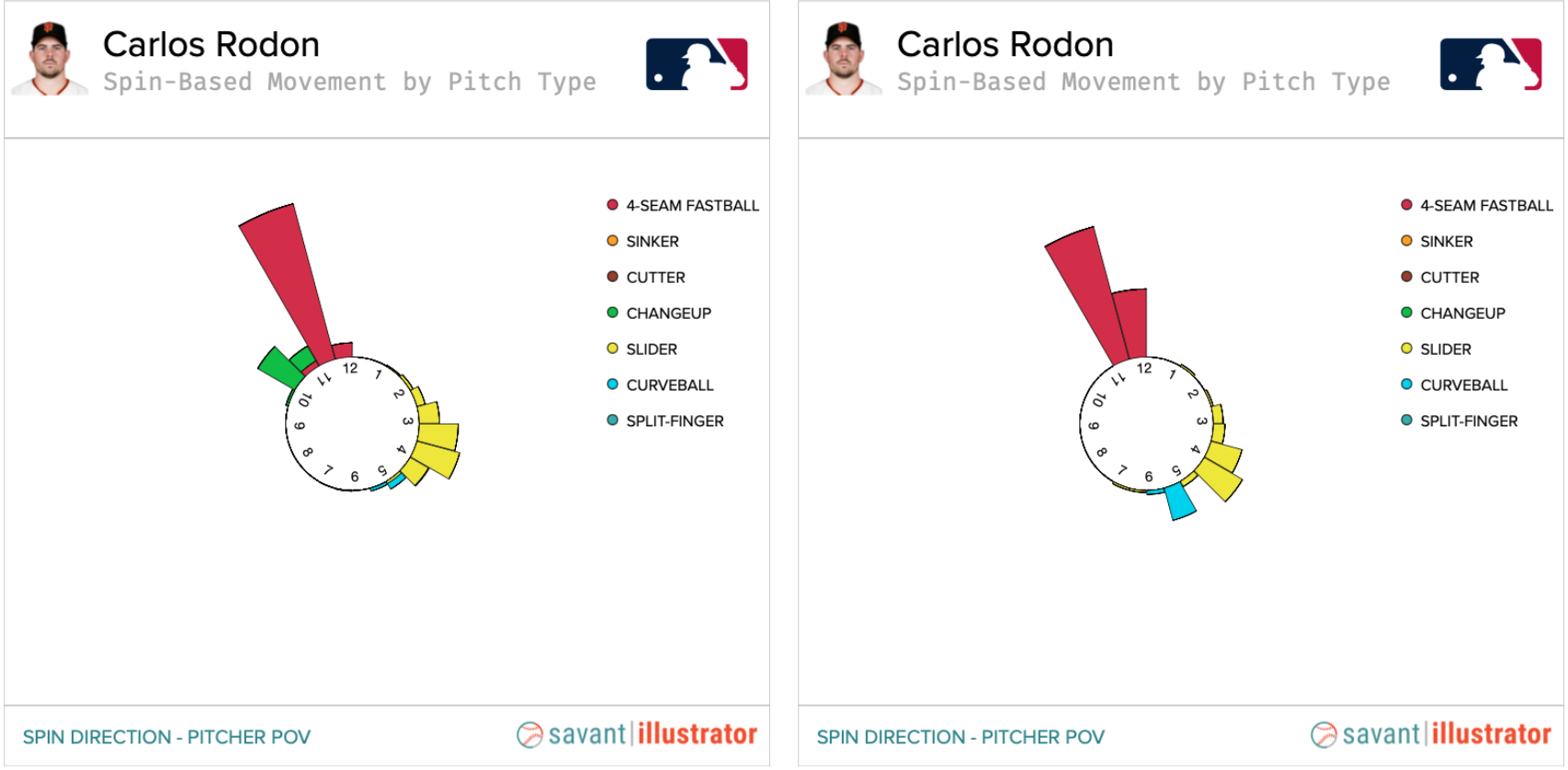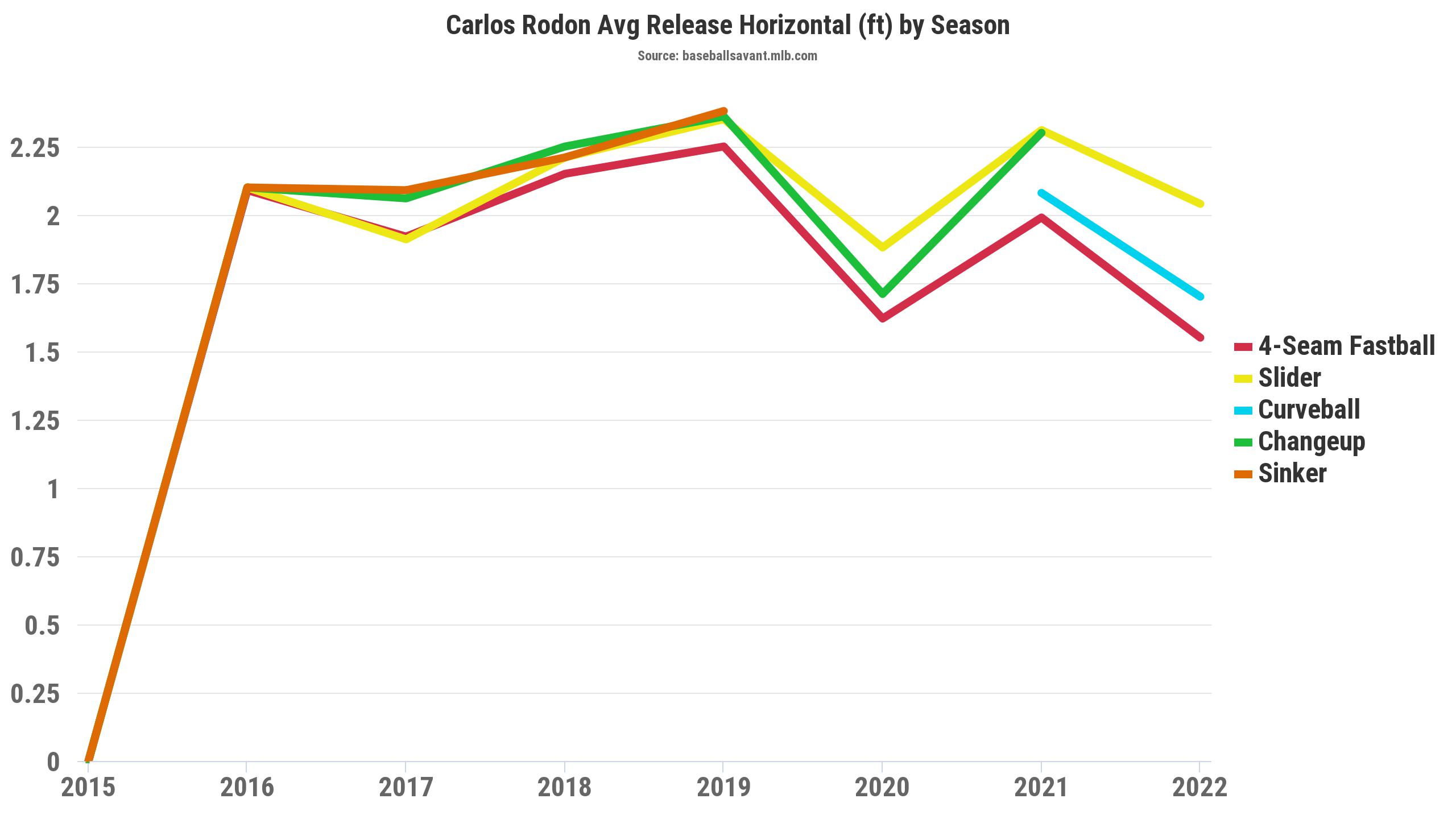Last season, I detailed how the San Francisco Giants‘ pitchers had almost completely abandoned curveballs. With the addition of Carlos Rodón to the rotation in the offseason, surely he or the Giants would scrap a pitch that in 2021 he only threw 38 times for a 1.000 batting average and 3.000 slugging percentage, right?
Not exactly.
Instead, Rodón in the early going has increased his curveball usage, but with one notable difference: it has seemingly been his best pitch this season.
First, we’ll begin with the caveat that we are still looking at extremely small sample sizes. Through the weekend, Rodón had started just three games and thrown all of 17 innings. His curveball itself has only been thrown 22 times, not enough for the pitch to become predictive of future results– however, we know that CSW% on curveballs stabilize more quickly than most other pitch types (around 30 pitches thrown). And, there are reasons to believe that the better results thus far on the pitch are a result of intentional adjustments; whether those results hold is what remains to be seen.
The difference between Rodón’s success with the curve has been night and day when compared to last season:

He’s getting more movement on all of his pitches, but the curveball is really noticeable. In 2021, Rodón was getting 7% less vertical drop on his curve than the MLB average but somehow has now adjusted that drop to be 6% above average. His horizontal movement on the pitch has been even more pronounced, going from 15% below average to 8% above. It’s transformed the pitch not just by results, but by movement as well.
Those could be explained in part by his throwing the curve harder and with more spin– it’s up to 2383 RPM after last year’s 2253 — but the way Rodón has thrown it seems to have changed, too.
The pitch is likely harder to pick up for batters, due to the pitch’s spin mirroring. Basically, the more pitches “mirror” each other in their direction of spin, the harder it is for a batter to recognize which pitch is coming. And Rodón’s curve has made clear strides in that regard:

The first graph is Rodón’s curveball from 2021. The 4-seamer and curveball are a little off-center. In the 2022 version on the right, the curveball spins in almost the exact opposite direction as the 4-seamer.
Hitters’ results against the pitch seem to back up the assertion that they’re having trouble picking it up, at least in April. Rodón is throwing the curve in the zone less than he did last year, but at the same time hitters are swinging and missing at it more. That seems ideal.
How exactly Rodón has made this adjustment may come down to a changing of his arm slot or release point on his pitches. We’ve talked about his curveball, but it’s worth noting that his other primary pitches, his 4-seamer and slider are also generating more movement, spin, and velocity than in 2021. The vertical release point has remained largely the same, but Rodón’s average horizontal release point has dropped on all of those pitches, after ticking upward in 2021:

Rodón’s pitch arsenal is up in almost any key metric. Of course, it’s still early in the season, and as his arm gets more mileage on it throughout the season, perhaps the velocity and spin gains will even out. That remains to be seen. But what has been clear in the early going is that Rodón has changed his release point across the board, and it’s likely created a more effective curveball.
The Giants may not have a problem with curveballs per se, as much as they have a problem with ineffective pitches in a pitcher’s arsenal. To that end, Rodón has completely scrapped his changeup in 2022, after throwing it 12% of the time in 2021. That pitch wasn’t very effective, either, producing a .348 xBA and .551 xSLG, but it is interesting that Rodón simply didn’t scrap the less effective curveball and call it a day.
Instead, he got rid of his second-least effective pitch and has completely transformed his least effective one into one that’s well above league average, both in results so far and in its underlying movement and velocity.
Much of the “stat line scouting” of pitch effectiveness from analysts (like me) boils down to “why doesn’t this pitcher throw his worst pitches less often?”
Rodón’s leap with his curveball reminds us that it’s much more complicated than that and that pitches play off of each other. Different pieces fit into a broader pitching arsenal and approach to keep hitters off balance.
Rodón’s curve has been a revelation while he’s eliminated his other below-average pitch. So far it has been extremely effective and provides us with another opportunity to marvel at pitch design and approach.
Photo by Frank Jansky/Icon Sportswire | Design by J.R. Caines (@JRCainesDesign on Twitter and @caines_design on Instagram)

